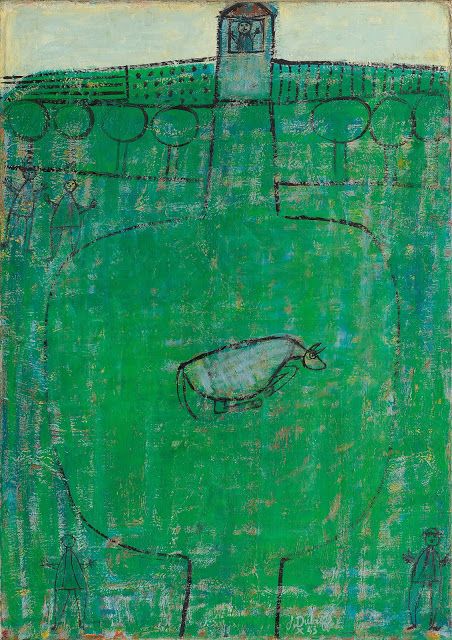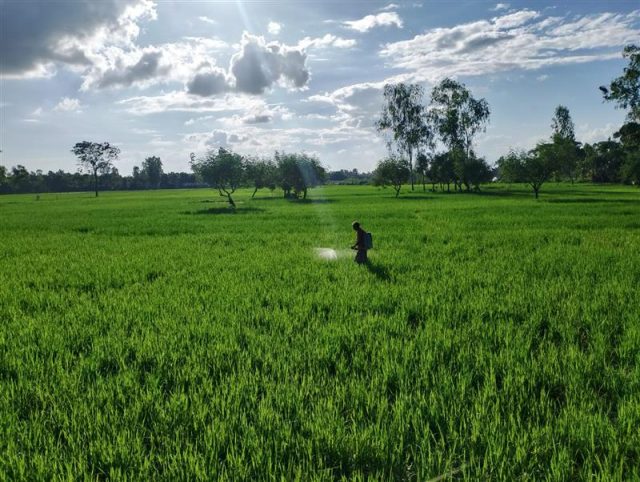FAO sets the record straight–86% of livestock feed is inedible by humans
- From
-
Published on
28.01.19
- Impact Area

Cow Jar, by Jean Dubuffet, 1943.
As the media frenzy caused by a ‘planetary health diet’ proposed in a new report from an EAT-Lancet commission this month continues, it is perhaps timely to recall that the Food and Agriculture Organization of the United Nations (FAO) has set the record straight regarding not just the level of greenhouse gases that livestock emit (see yesterday’s posting on this blog) but also incorrect information about how much food (crops eatable by humans) is consumed by livestock. It’s not a lot.
The EAT-Lancet report summarizes scientific evidence for a global food system transition towards healthy diets from sustainable agriculture. The report concludes that a global shift towards a diet made up of high quantities of fruits, vegetables and plant-based protein and low quantities of animal protein could catalyze the achievement of both the 17 Sustainable Development Goals (SDGs) and the landmark 2015 Paris Agreement to combat climate change.
Anne Mottet, an FAO livestock development officer specializing in natural resource use efficiency and climate change, usefully informs us of incorrect, if widespread, information and understanding about the so-called ‘food-feed competition’.
What does her research study show?
What most livestock in the world mostly eat is grass and other forages and crop ‘wastes’ and by-products.
What most livestock in the world mostly don’t eat is grain fit for human consumption.
Here is a summary of her research on this topic.
‘. . . [L]ivestock use a large share of agricultural land and are often considered a resource drain. Particularly criticized is the low efficiency of livestock to convert feed into human edible protein and the competition for the use of cereals as livestock feed or for direct human food.
A new study by FAO and published in Global Food Security found that livestock rely primarily on forages, crop residues and by-products that are not edible to humans and that certain production systems contribute directly to global food security, as they produce more highly valuable nutrients for humans, such as proteins, than they consume.
‘. . . Animal food sources make a vital contribution to global nutrition and are an excellent source of macro- and micronutrients. Livestock products make up 18% of global calories, 34% of global protein consumption and provides essential micro-nutrients, such as vitamin B12, iron and calcium. Livestock use large areas of pastures where nothing else could be produced. Animals also add to agricultural production through manure production and drought power. Further, keeping livestock provides a secure source of income for over 500 million poor people in many in rural areas.
This study determines that 86% of livestock feed is not suitable for human consumption.
If not consumed by livestock, crop residues and by-products could quickly become an environmental burden as the human population grows and consumes more and more processed food.
Animals also consume food that could potentially be eaten by people. Grains account for 13% of the global livestock dry matter intake.
Some previous studies, often cited, put the consumption of grain needed to raise 1 kg of beef between 6 kg and 20 kg.
Contrary to these high estimates, this study found that an average of only 3 kg of cereals are needed to produce 1 kg of meat at global level.
It also shows important differences between production systems and species.
For example, because they rely on grazing and forages, cattle need only 0.6 kg of protein from edible feed to produce 1 kg of protein in milk and meat, which is of higher nutritional quality. Cattle thus contribute directly to global food security.
The study also investigates the type of land used to produce livestock feed. Results show that out of the 2.5 billion ha needed, 77% are grasslands, with a large share of pastures that could not be converted to croplands and could therefore only be used for grazing animals.
‘. . . Animal production, in its many forms, plays an integral role in the food system, making use of marginal lands, turning co-products into edible goods, contributing to crop productivity and turning edible crops into highly nutritious, protein-rich food. Quantifying the land and biomass resources engaged in livestock production and the food output they generate, but also improving our modelling capacity by including trends in consumer preferences, shifts in animal species, climate change impacts, and industrial processes to improve the human edibility of certain feed materials is arguably basic information needed as part of further research into the challenge of sustainably feeding 9.6 billion people by 2050,” concluded the authors.’
Read the whole article on the FAO website: More fuel for the food/feed debate: New FAO Study indicates that livestock primarily consume foods not fit for human consumption and meat production requires less cereals than generally reported, 3 Dec 2018.
Related posts on the ILRI blogs
Should we eat red meat? Depends on who’s eating—New York Times, 22 Jan 2019.
FAO sets the record straight on flawed livestock emission comparisons–and the livestock livelihoods on the line, 27 Jan 2019.
IFPRI’s Shenggen Fan on the ‘differentiated approach’ needed to navigate today’s food systems, 26 Jan 2019.
With huge variations in meat consumption, we’re ‘all in this existential crisis together’,—Vox, 25 Jan 2019.
African livestock: A terrible thing to waste,22 Dec 2018.
A move away from ‘grain fundamentalism’ to higher quality milk, meat and egg calories to fight malnutrition, 15 Nov 2018.
Yes, eating meat affects the environment, but cows are not killing the climate, 30 Oct 2018.
‘High-yield’ farming costs the environment less than previously thought—and could help spare habitats, 20 Sep 2018.
FAO on the common but flawed comparisons of greenhouse gas emissions from livestock and transport, 19 Sep 2018.
Squaring the meat vs veganism circle, 6 Sep 2019.
Why livestock belong on the table—whether we eat meat or not, 26 Jun 2018.
Is promoting vegetarianism for all the world’s people a form of colonialism? just Euro-centric?, 26 Jun 2018.
A better way for vegans, vegetarians, meat eaters and livestock herders alike—By ecologist Ian Scoones, 22 Jun 2018.
Livestock-enhanced diets in the first 1,000 days of life: Pathways to better futures in low-income countries, 19 Jun 2018.
It’s not enough to go vegetarian to fight climate change, 11 Jun 2018.
Checking the facts behind the ‘livestock facts’ we think we know, 6 Jun 2018.
Avoiding meat and dairy is ‘the single biggest way’ to harm poor livestock herders, 5 Jun 2018.
New studies provide the first accurate estimates of greenhouse gas emissions from East African livestock, 3 Jun 2018.
Shirley Tarawali on convergence in consumption of milk, meat, eggs at the Global Forum for Food and Agriculture, 26 Mar 2018.
Mobile pastoralism—A 10,000-year-old practice still robust, if threatened, in the Mediterranean today, 19 Mar 2018.
Cleaning up assessments of livestock-environment systems in developing countries with CLEANED, 16 Mar 2018.
Lora Iannotti on livestock and animal-source foods at Berlin’s Global Forum for Food and Agriculture, 6 Mar 2018.
BMZ’s Stefan Schmitz on sustainable solutions for the livestock sector, 5 Mar 2018
Beef cattle grazing on American rangelands—not feedlots—could be net carbon sink, 27 Feb 2018.
Cereal straws and stovers for sustainable livestock futures: When crop biomass becomes livestock gold, 27 Feb 2018.
’If you care about agriculture, you care about livestock’—Bill Gates, 30 Jan 2018.
Jimmy Smith speaks in Australia on the pursuit of a ‘low-emissions cow’ and other livestock matters, 3 Jan 2018.
Livestock in developing countries—Misperceptions, facts and consequences, 5 Oct 2017.
![]()
Related news
-

Reinventing Kenya’s Snack Future with Dryland Grains
International Crops Research Institute for the Semi-Arid Tropics (ICRISAT)21.11.25-
Nutrition
-
Poverty reduction, livelihoods & jobs
Faces of Impact - Video Feature Story On a quiet backstreet in Mihango, Kenya, the…
Read more -
-

Cultivating climate-smart rice: How specific cultivars and smarter fertilizing can cut emissions and maintain yield
International Rice Research Institute (IRRI)19.11.25-
Climate adaptation & mitigation
-
Food security
By Bushra Humaira Sadaf A team of researchers from the Bangladesh Rice Research Institute (BRRI), I…
Read more -
-

COP30 can enable Greening Plant Nutrition in East and Southern Africa
International Rice Research Institute (IRRI)17.11.25-
Nutrition
Image creditAfrica rice farming by majimazuri21, Pixabay Licence By Jamie Males (republished from …
Read more -

